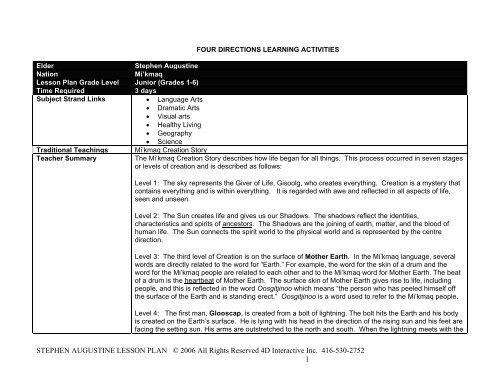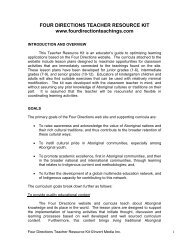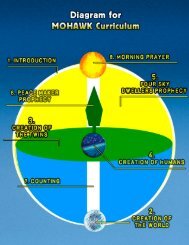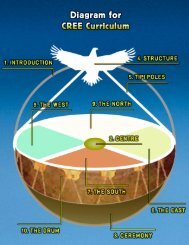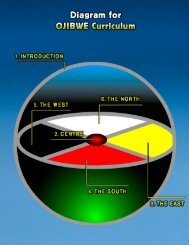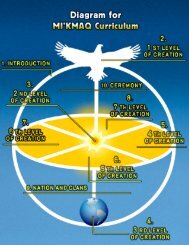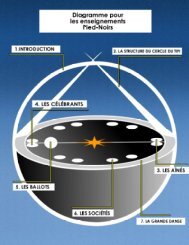Mi'kmaq Creation Story - Four Directions Teachings.com
Mi'kmaq Creation Story - Four Directions Teachings.com
Mi'kmaq Creation Story - Four Directions Teachings.com
Create successful ePaper yourself
Turn your PDF publications into a flip-book with our unique Google optimized e-Paper software.
FOUR DIRECTIONS LEARNING ACTIVITIESElderStephen AugustineNationMi’kmaqLesson Plan Grade Level Junior (Grades 1-6)Time Required3 daysSubject Strand Links • Language Arts• Dramatic Arts• Visual arts• Healthy Living• Geography• ScienceTraditional <strong>Teachings</strong> Mi’kmaq <strong>Creation</strong> <strong>Story</strong>Teacher SummaryThe Mi’kmaq <strong>Creation</strong> <strong>Story</strong> describes how life began for all things. This process occurred in seven stagesor levels of creation and is described as follows:Level 1: The sky represents the Giver of Life, Gisoolg, who creates everything. <strong>Creation</strong> is a mystery thatcontains everything and is within everything. It is regarded with awe and reflected in all aspects of life,seen and unseen.Level 2: The Sun creates life and gives us our Shadows. The shadows reflect the identities,characteristics and spirits of ancestors. The Shadows are the joining of earth, matter, and the blood ofhuman life. The Sun connects the spirit world to the physical world and is represented by the centredirection.Level 3: The third level of <strong>Creation</strong> is on the surface of Mother Earth. In the Mi’kmaq language, severalwords are directly related to the word for “Earth.” For example, the word for the skin of a drum and theword for the Mi’kmaq people are related to each other and to the Mi’kmaq word for Mother Earth. The beatof a drum is the heartbeat of Mother Earth. The surface skin of Mother Earth gives rise to life, includingpeople, and this is reflected in the word Oosgitjinoo which means “the person who has peeled himself offthe surface of the Earth and is standing erect.” Oosgitjinoo is a word used to refer to the Mi’kmaq people.Level 4: The first man, Glooscap, is created from a bolt of lightning. The bolt hits the Earth and his bodyis created on the Earth’s surface. He is lying with his head in the direction of the rising sun and his feet arefacing the setting sun. His arms are outstretched to the north and south. When the lightning meets with theSTEPHEN AUGUSTINE LESSON PLAN © 2006 All Rights Reserved 4D Interactive Inc. 416-530-27521
Learner ObjectivesSuggested TeachingStrategiesteachings on how to rely on each other and to respect and care for one another. In this way, they live agood life.Knowledge/Understanding:• To understand creation from a Mi’kmaq perspective• To reflect, deconstruct and evaluate the Mi’kmaq <strong>Creation</strong> <strong>Story</strong>Inquiry/Values:• To provide theoretical aspects of the creative process to role playing• To explore characters and issues drawn from the Mi’kmaq <strong>Creation</strong> <strong>Story</strong>• To appreciate the importance of physical fitness and healthSkills/Applications:• To develop proficiency in listening, speaking, writing, questioning and negotiating• To experience first hand the roles of performer, audience, and playwright• To use non-verbal <strong>com</strong>munication to portray character and define relationships amongst characters• To create art pieces that reflect emotion and mood1. Generate a discussion on where the first people came from. Introduce the concept that peoplehave different ideas on where humans <strong>com</strong>e from. The Mi’kmaq, for instance, have a story about<strong>Creation</strong>. One of their Elders, Stephen Augustine, has traditional teachings to share about theMi’kmaq story of <strong>Creation</strong>.2. View www.fourdirectionteachings.<strong>com</strong> together as a class to hear the Mi’kmaq <strong>Creation</strong> <strong>Story</strong> andteachings of Stephen Augustine.3. a) Individually or in pairs, have students listen to Stephen’s teaching, “The First Level of <strong>Creation</strong>.”Discuss seasons and other concepts of cycles (e.g. life and death, the calendar, weather patterns, etc.)On a piece of flipchart paper, have the students make illustrations and/or list how cycles are importantto life and to the creation story.b) Listen to “The Second Level of <strong>Creation</strong>,” and lead a discussion about shadows and how they arecast. Take a walk outside with your students and have them notice their shadows. With chalk, havethe students work in small groups or pairs to outline their shadows. Have them pose in different ways.Have them notice how stretched out they are at certain times of the day and how short they are at othertimes. Ask the students if they can figure out any patterns related to time of day and shadow length.For indoor activities, have the students create silhouette drawings of their bodies or profiles. Makeshadow puppets using the Mi’kmaq <strong>Creation</strong> <strong>Story</strong> characters.c) Listen to “The Third Level of <strong>Creation</strong>,” and discuss the importance that Mother Earth has forSTEPHEN AUGUSTINE LESSON PLAN © 2006 All Rights Reserved 4D Interactive Inc. 416-530-27523
everyone. Ask the students what they can do as a class to show kindness and respect towards theEarth. Suggest that the students plan a clean up day once or twice a month of the school yard, or ifpossible to participate in a gardening project. This will allow the students some extra time to spendoutside. Other ways to get outside and learning are to plan a walk to a nearby park or trail area, oreven around the block. Have the students notice any small and interesting plants; try to identifydifferent tree species in your area by using a species key.Since the heartbeat of Mother Earth is the drumbeat, schedule a visit from a First Nations drummer. Ifa professional drummer is not available, bring in some drums to the class and teach about beat, rhythmand coordination. Have students build simple drums by using simple materials.d) Listen to “The <strong>Four</strong>th Level of <strong>Creation</strong>,” and discuss how the senses are important for us. Havestudents understand about the importance of hearing by taking them outside to listen to as manysounds as possible. Have the students write down in a list all of the kinds of sounds that they can hear.Have them categorize which sounds they find calming, annoying, loud, high-pitched, natural, andhuman-made. Ask the students if trees make sounds. Do different trees make different sounds? Dotrees make specific sounds right before it rains? Have the students create their own sound effects toemphasize specific situations/scenarios, e.g. wind, traffic jam, train. Let the students know thatlistening is extremely important to the <strong>Creation</strong> <strong>Story</strong>.e) Listen to “The Fifth Level of <strong>Creation</strong>,” and discuss rocks and minerals. Grandmother was bornfrom a rock, which is part of Mother Earth. Teach the students about different types of rock(metamorphic, sedimentary and igneous). Visit some areas where the students can gather small rocksand stones to make a small rock garden. Students can learn about fossils and how mildly acidic rainfallaffects certain types of rock (limestone). Let the students look at rocks and minerals more closely withmagnifying lenses.f) Listen to “The Sixth Level of <strong>Creation</strong>,” and discuss the importance of good physical fitness andhealth. Have the students perform fitness tests with kits provided by the Heart and Stroke Foundationof Canada. These kits have short jumping ropes and double dutch lengths. Jumping rope and creatingother types of games are fun ways to promote physical fitness. Plan a full or half day of fun physicalactivities (e.g. winter or summer obstacle courses, sled races, race relays, three-legged races.)g) Listen to “The Seventh Level of <strong>Creation</strong>,” and discuss the colour wheel. Teach the primary coloursand how to make secondary colours by mixing the primary colours. Make a large collaborative artpiece which focuses on colour as the main element of the piece. Divide the students into major colourgroups and have each group design and paint images and symbols that can be associated with theirSTEPHEN AUGUSTINE LESSON PLAN © 2006 All Rights Reserved 4D Interactive Inc. 416-530-27524
colour, e.g. yellow sun, birds, flowers. Collage the pieces together to create a classroom collaborativeart piece. The students will be reminded of the association of Glooscap’s mother’s gift of colour to theworld.3. In groups, have students review the seven levels of creation as told by Stephen Augustine. Thedirections are very important to the creation of Glooskap. Ask the students if they can point out thefour directions. Play a game with the students: block out the curtains/windows and have studentsmove to the parts of the room that they believe that direction to be in. If you call out “East!” thestudents should move to where they believe East is located. Do not give them any hints but thestudents can assist each other if you permit. Make it an elimination game where students who arenot in the Eastern direction are eliminated and need to sit on the ground or in the middle of theclass. The remaining students can continue to play. Call out “North!” and the first three students toget there can continue to play and everyone else is eliminated. Call out any other direction andhave a single winner. You can play this type of game outside or blindfolded and have the studentsuse their other senses to guide them in choosing the correct direction e.g. sound cues, traffic,school yard noises, etc. In winter, the students can map out the route that Glooscap took on hisearlier journeys. The students can start out in the East and then walk towards the west, trackingtheir steps in the snow. The student then walks to the South and then North to finally meet up tothe east again. What design/shape is in the snow? Have the students <strong>com</strong>pare these shapes withimages that were etched into the cliffs of Kejimkujik National Park, located in Southwestern NovaScotia. These images are called petroglyphs.4. Discuss the meaning of the Mi’kmaq <strong>Creation</strong> <strong>Story</strong>. Why do the Mi’kmaq use the terms “MotherEarth” and “Grandfather Sun?” How was Glooscap created? Why did Glooscap ask permission tokill the animals? What did Glooscap do after killing the animals? Why did he do this? What didGrandmother teach him? What did Glooscap learn from his mother?5. As a class, make a master chart of all the ideas on the characters of the story, their looks, and theirwords. Develop a script to tell the story from beginning to end and act it out in a drama production.Assign characters to play the roles of Glooscap, Grandfather Sun, The Giver of Life, Grandmother,Mother Earth, Whirlwind, and Glooskap’s mother and nephew. Play a drum to represent theheartbeat of Mother Earth and/or play a Mi’kmaq song (see links below). Invite parents to see thefinal production.Optional Exercises:STEPHEN AUGUSTINE LESSON PLAN © 2006 All Rights Reserved 4D Interactive Inc. 416-530-27525
Vocabulary • <strong>Creation</strong>• Level• Permission• Petroglyph• The Mi’kmaq have many stories about Glooscap. If possible, invite a Mi’kmaq elder to the class totell more stories about Glooskap, his twin brother, etc.• Reflect on the Mi’kmaq <strong>Creation</strong> <strong>Story</strong> in journals. Explain what it says about how people shouldtreat animals and plants and why.• Make a petroglyph class mural using finger paints, charcoal, and pastels. The students can modeltheir images from the ones seen in Kejimkujik National Park. Add other elements such ashandprints, animal prints, animal images, etc.Materials Required • Flipchart• Costume materials• Drum• Paper• Paints, pastels, charcoal• Magnifying glasses• Physical fitness kits, jumping ropesEvaluation1. Teacher evaluation of charts for <strong>com</strong>pletion and accuracy2. Teacher evaluation of script development participation3. Peer evaluation of role-playing creativity4 Student observation checklist5. Physical fitness heart rate chart6. Anecdotal recordsSTEPHEN AUGUSTINE LESSON PLAN © 2006 All Rights Reserved 4D Interactive Inc. 416-530-27526


